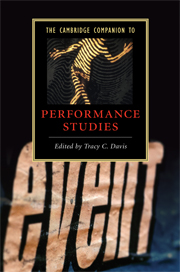Book contents
- Frontmatter
- Introduction: the pirouette, detour, revolution, deflection, deviation, tack, and yaw of the performative turn
- Part I Social polities: history in individuals
- Part II Body politics: the individual in history
- 7 Live and technologically mediated performance
- 8 Moving histories: performance and oral history
- 9 What is the “social” in social practice?: comparing experiments in performance
- 10 Live art in art history: a paradox?
- 11 Queer theory
- Further reading
- Index
11 - Queer theory
from Part II - Body politics: the individual in history
Published online by Cambridge University Press: 28 January 2009
- Frontmatter
- Introduction: the pirouette, detour, revolution, deflection, deviation, tack, and yaw of the performative turn
- Part I Social polities: history in individuals
- Part II Body politics: the individual in history
- 7 Live and technologically mediated performance
- 8 Moving histories: performance and oral history
- 9 What is the “social” in social practice?: comparing experiments in performance
- 10 Live art in art history: a paradox?
- 11 Queer theory
- Further reading
- Index
Summary
The word “queer,” like the word “performance,” has a vexed historical trajectory. Once a pejorative slur targeted at gender and sexual nonconformists, queer is currently also a hip signifier of postmodern identity. To embrace “queer” is to resist or elide categorization, to disavow binaries (that is, gay versus straight, black versus white) and to proffer potentially productive modes of resistance against hegemonic structures of power. This deployment of queer, then, exemplifies the traits of performance in that “its definitional indeterminacy, its elasticity, is one of its constituent characteristics.” In academic circles queer has become a catalyst for theorizing not only gender and sexuality in ways that detach them from singular or rigid identitarian markers, but also a way to discuss race and class in antiessentialist ways. A poor, fifty-year-old, African American female rugby player from the southern United States might be considered “queer,” for instance, because each of the adjectives that describe her do not comport with the traditional ideas of who plays rugby. According to this logic, this particular player is queer because she is anomalous, odd, or strange in the world of rugby. It is this oddity and strangeness that queer theorists would use to argue that all identity is fraught because it is always already mediated through language and ceded to those who have the power to control representation. Thus this player's queerness can be taken as subversive because her presence in the rugby league - a sport typically populated by white middle-class men - transgresses the image of the “rugby player” in the social imaginary and potentially deconstructs power relations within the context of rugby as a sport. Through the slide from personal pronoun to active verb (for example, “I am a queer” to “The actor queered the character”), the term has been reappropriated to activate a way to theorize subjectivity, social relations, and culture in general.
- Type
- Chapter
- Information
- The Cambridge Companion to Performance Studies , pp. 166 - 181Publisher: Cambridge University PressPrint publication year: 2008
- 3
- Cited by

